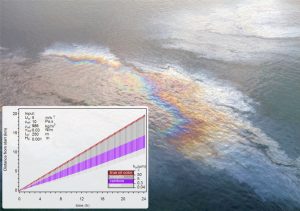Modeling Study Develops Approach to Compare Oil Slick Dispersion Scenarios
– JANUARY 16, 2018
Researchers developed an algorithm that accounts for different wind speeds, oil types, natural dispersion processes (breaking waves), and chemical dispersant application to analyze oil slick evolution scenarios. The model results indicate how the oil slick will become thinner and dissipate over time as a result of dispersion. In the least favorable slick dispersion scenario, the slick size increases as it develops a long upwind tail (see image). In the most favorable scenario, oil slick size only slightly increases while oil layer thickness decreases until the slick disappears. The simulations showed that chemical dispersants improved or enhanced slick dispersion under low wind speed and medium or light oil conditions. In other cases, the dispersion created by environmental conditions was already so successful that chemical dispersants provided less than 10% additional dispersion. The researchers published their findings in Journal of Geophysical Research: Oceans: Predicting the consequence of natural and chemical dispersion for oil slick size over time.
Deciding on application of chemical dispersants remains a complex trade-off between the adverse effects of floating oil and those of suspended/dissolved/sunken oil. The potential for and reality of various adverse effects are the subjects of other research funded by the Gulf of Mexico Research Initiative (for example, The State-of-the-Art Unraveling of the Biotic and Abiotic Chemical Evolution of Macondo Oil: 2010-2018 and Deep-sea Risk Assessment and species sensitivity to WAF, CEWAF and Dispersant).
Current algorithms for modelling surface oil dispersion rely on estimates about the effectiveness of chemical dispersants to enhance the natural dispersion of surface oil. However, these algorithms do not provide information about the effectiveness of chemical dispersant application compared to that of natural dispersion. This study provides a means for making these comparisons with an approach that accounts for the continuous entrainment of oil, resurfacing process of different oil droplet sizes, and the horizontal transport of oil.
The researchers analyzed simulated oil slicks under conditions with three wind speeds (5, 10, and 15 m/s), three oil types (light, medium, and heavy oil), and two dispersant conditions (natural and chemical dispersion) over a 24-hour period. An optimal dispersion scenario would yield a smaller, thinner, symmetrical slick and suboptimal dispersion would create a long, thin tail upwind of the main slick.
Wind speed and related mixing conditions had a clear, large influence on slick fate. Medium and high wind speed scenarios showed less than 2% of dispersed droplets resurfacing during the observed time period compared to 6 – 21.9% of droplets resurfacing in low wind speed simulations. High and medium winds left less than 5% oil on the surface compared to low wind speed that left 10 – 70% of surface oil.
The influence of oil type on the slick length, transport, and oil volume was hardly noticeable. Although increasing oil viscosity increased the mean droplet size, the effect on the droplet rise speed was compensated by the higher density of oil. However, oil properties could have an indirect effect on slick development through their influence on the initial slick spreading and, thus, thickness. The initial oil slick thickness had a larger effect on the slick evolution than on slick length, as thicker slicks are harder to disperse, and had a larger influence over time. Chemical dispersants reduced oil slick size in the case of suboptimal natural dispersion, with the exception of extremely unfavorable conditions in which the slick size would increase.
The team developed a dispersability factor that combined oil slick properties and environmental conditions into one value. Analysts can use this dispersability factor as a favorability indicator of natural dispersion and the potential added value of chemical dispersion. The authors suggest that future research should aim to quantify and validate full slick surface expression in 3-D, taking into account mass loss by other weathering and spreading processes and variable weather conditions.
Data are publicly available through the Gulf of Mexico Research Initiative Information & Data Cooperative (GRIIDC) at doi:10.7266/N7SQ8XFT.
The study’s authors are Marieke Zeinstra-Helfrich, Wierd Koops, and Albertinka J. Murk.
************
This research was made possible in part by a grant from the Gulf of Mexico Research Initiative (GoMRI) to the Center for the Integrated Modeling and Analysis of Gulf Ecosystems II (C-IMAGE II). Other funding sources included the Wageningen UR, IPOP TripleP@Sea innovation program (KB-14–007).
The Gulf of Mexico Research Initiative (GoMRI) is a 10-year independent research program established to study the effect, and the potential associated impact, of hydrocarbon releases on the environment and public health, as well as to develop improved spill mitigation, oil detection, characterization and remediation technologies. An independent and academic 20-member Research Board makes the funding and research direction decisions to ensure the intellectual quality, effectiveness and academic independence of the GoMRI research. All research data, findings and publications will be made publicly available. The program was established through a $500 million financial commitment from BP. For more information, visit https://gulfresearchinitiative.org/.
© Copyright 2010-2018 Gulf of Mexico Research Initiative (GoMRI) – All Rights Reserved. Redistribution is encouraged with acknowledgement to the Gulf of Mexico Research Initiative (GoMRI). Please credit images and/or videos as done in each article. Questions? Contact web-content editor Nilde “Maggie” Dannreuther, Northern Gulf Institute, Mississippi State University (maggied@ngi.msstate.edu).






